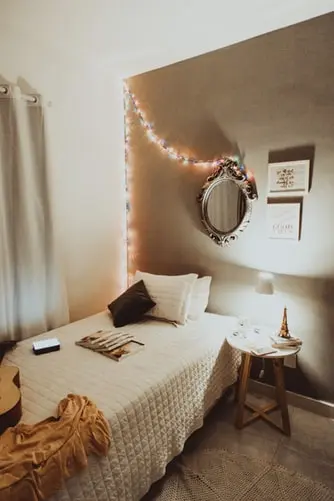Is your sleep or peace been constantly disturbed by external noise?. It is so hard to sleep when sound waves pass through your wall into the room when you are trying to catch some sleep after a hard day’s work.
Today, I will share with you ways on how to soundproof a bedroom wall to dispel any unwanted noise from entering your room. If not completely eliminate it, at least the noise will be reduced drastically.
In my situation not only was the noise from the busy highway disturbing me, but I also shared a wall with a noisy neighbor.
After a couple of days of sleepless nights because of the noise, I approached him and asked calming if he could reduce the noise a little bit.

Of course, he listened but soon he forgot about our conversation and went back to his normal ways. That was when I started looking for solutions to my problems.
And as someone who is trained to find solutions to problems, the best solution I thought which was also under my control is to soundproof my room’s walls.
Here, with my little tricks, I am about to share with you on how to soundproof a wall cheaply, you can actually apply them when soundproofing existing walls in your home.
You can do the soundproofing on your own without any need to hire a professional. You can hire an expert if you don’t have the time and have some money to do so. Otherwise, you can use these ideas here to do it yourself.
How to soundproof your bedroom ceiling
Ways to soundproof your bedroom floor
Soundproofing Existing Walls
Quick Preview of Materials You Might Need to Soundproof Your Bedroom Wall Cheaply
- Foam Mats
- Vinyl Mats
- Weatherstrip Tape
- Green Glue
- Soundproof Curtains
1 . Identify the Weaker Areas in the Room
When it comes to soundproofing a bedroom, you need to identify which weaker areas in the room is the sound waves traveling through into the room. The windows and the door are the biggest culprits.
This is because windows and doors in a room have more gaps and cracks than anywhere else in the room.
If it is possible the noise is passing through those areas, it will be a good idea to first soundproof your door and windows first.
Even though I have written separate posts about how to soundproof a door and windows cheaply, here I will recommend using a weatherstrip tape to seal all gaps and cracks on your windows and doors.
Weatherstrip tape is a plastic, silicon or steel piece of material that you would simply put on the bottom of your door to cover some holes.
This way, the weatherstrip tape will reduce noise leakage.
Another effective and cheap way to reduce noise into the bedroom will be to use soundproof curtains on both the doors and the windows after you have sealed any gap that could be letting noise into the room.
2 . Identify the Source of the Noise
Knowing where the sound is coming from will help you determine the type of noise and which materials will be suitable for reducing it.
There many types of noise. But the two main noise types are impact noise and airborne noise.
Impact sound is a form of structure-borne sound that occurs when an object impacts on another, resulting in the generation and transmission of sound.
Structure-borne noise may also be generated by vibration sources rather than impact sources. A typical example of impact sound is footsteps on the floors. Impact noise is of low frequency and can be a little hard to insulate.
Vinyl mats are thick soundproofing mats that can be put up against the walls in order to reduce the low-frequency bass and overall noise.
Airborne noise or airborne sound, on the other hand, is defined as any sound that is transmitted by the air, like music or speech.
Sound waves are picked up and carried by air until they crash into something solid, like a wall. The collision sends vibrations through the wall and into the space beyond it.
This is why you’re able to hear your neighbor’s TV sound as if it were inside your home; the sound waves created are carried by air until they reach your walls and vibrate through them.
While it is impossible to eliminate all airborne noise, there are a number of ways to greatly reduce it. If you have come to the conclusion that the noise you are hearing is airborne, then t
If you aren’t on a very tight budget, acoustic gyprock could help save you time and precisely pinpoint the place where the most noise comes through by installing it in a couple of different spots around the room (on top of your wall – mostly in the corners).
3. Put Some Drywall
Putting drywall up is more expensive than the options mentioned above but it is sure worth the extra money.
Drywall is also known as plasterboard, wallboard, sheetrock and many other names that people choose to call it. It is a panel made of calcium sulfate dihydrate with or without additives, typically is extruded between thick sheets of facer and backer paper.
Drywall is a very good insulate of noise, especially for walls and ceilings. What it does is, it adds extra mass to your thin walls. Thereby insulating them against unwanted noise from outside.
So, if you think you should rather go for that option, then you will have to also budget in a professional. This is because drywall is a bit harder to install on your own.
Since it is a board that has to fit properly on your interior walls, you will need to take the wall’s dimensions. This way you will be able to purchase one that will fit well on your wall.
4. Fill the Room with More Things
Empty things make the most noise. If your bedroom is very empty, the impact of the sound waves is much felt. But if you fill it up with some nice things like a chair, wall arts, closets, and other bedroom items, the amplitude of the echoes is reduced.
You should not expect some unbelievable results but these are basics to reducing echo. If you’re dealing with a very small amount of noise – this might actually help and cover it up until you can save some money to invest in a soundproof mat, acoustic board, or any other type of noise isolation.
Soundproofing Wall Without Removing Drywall
IF drywall already exists in the room walls, then soundproofing the existing wall without removing the drywall is possible.
First of all, you will need to examine the existing wall to see if there are any gaps that might be causing leakage. Or maybe the drywall has got some holes in it. This way you will have to patch those holes and see if the sound is still leaking into the room.
I will recommend you get This Stella Drywall Repair Kit to fix the drywall yourself and save some money.
After all the holes are fixed, you can now soundproof your existing drywall with items such as soundproof blankets, soundproof curtains, and even acoustic foams.
These are all effective soundproofing materials for walls.
Another great way to soundproof existing wall is to use your furniture, books shelf, etc against the sound affected wall. This way the noise will be reduced.
Use Caulk Sandwich: As an extra defense, separate the two layers of drywall with 3/8-inch-thick beads of acoustical caulk. The caulk deadens vibrations that try to travel from one layer of drywall to the other.
On Soundproofing a Bedroom Wall
- How to Chew Quietly While Eating-Effective Tips - April 14, 2023
- Why is My Clutch Pedal Squeaking – Causes & Fixes - April 14, 2023
- Propane Tank Making Hissing Noise (Solved) - February 25, 2023
